Those little flies hovering around are super annoying, but the good news is that there are several ways you can get rid of gnats in your plants naturally.
These tiny buggers have become a big problem in many households lately, including mine! In over ten years of owning dozens of houseplants I had never had a problem with fungus gnats until 2020.
Are you one of those people too? I think the reason why so many people are having a gnat infestation is because we’re all spending more time at home and (accidentally) overwatering our plants.
You’d be surprised how many plants actually prefer less water than too much. Of course, there’s your diva plants like the gorgeous Calathea White Fusion that can’t miss a watering by 5 minutes, but generally speaking, it’s better to underwater than overwater.
This post contains affiliate links, which means I may make a small commission if you click through and make a purchase.
What Causes Fungus Gnats
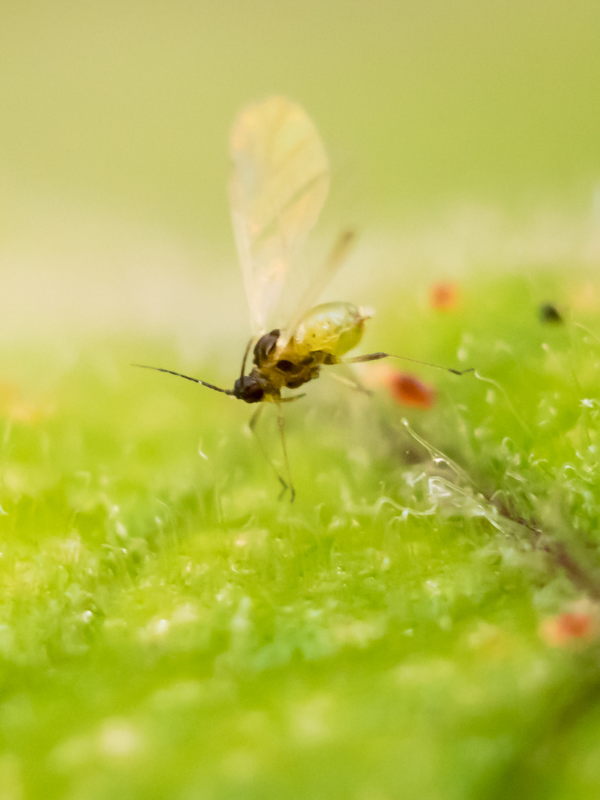
These little flies are attracted to fungus that grows in soil that’s too wet and the rotting parts of your plant.
For example, I accidentally left my orchid sitting in water for a few days which caused some of the roots to rot without me noticing for a few days. Thankfully, dying orchids can be saved.
Gnats can also be present in new houseplants that you bring home which is why you should quarantine them for 2 weeks to keep pests away from your established plants.
Unfortunately gnats are sometimes found in the potting soil mix that you buy, so always use the highest quality soil you can afford, and stay away from Miracle Grow.
How to Get Rid of Gnats in Plants Naturally
There are several ways you can get rid of fungus gnats without using chemicals. And the best part is that you probably have many of these items in your home.
My list below is outlined in order of what I usually do, but you can use any or all of these methods to kill fungus gnats in your indoor plants naturally (and prevent them from coming back).
Just remember that you need to kill both the gnats you see flying around (adults) and their eggs and larvae hidden beneath the soil.
Get Rid of the Old Soil and Repot
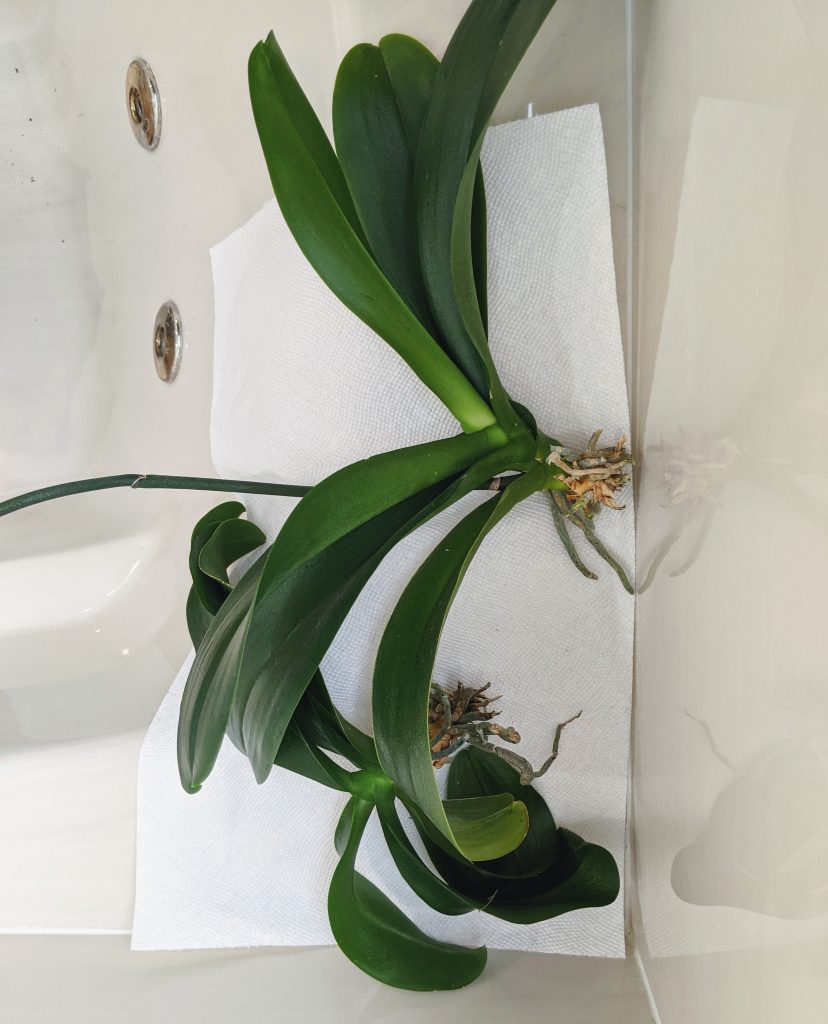
The fastest way to get rid of gnats is to dispose of all the soil from the culprit plant. Because for every gnat you see flying around the room, there are hundreds of eggs laying beneath the soil.
The first thing I do is take the plant out of the soil and inspect the roots. They will likely be soggy or moist, so lay it down on a paper towel and let it dry out a bit.
Cut off any dead or rotting roots (always with a sterilized knife or pair of sheers).
Having the proper indoor plant tools makes this step much easier.
While the roots are drying, empty the pot and clean it really well, even with bleach if you can. Then, repot it with the new soil and the cleaned up roots.
Consider using LECA (lightweight expanded clay aggregate). LECA helps regulate the amount of water that gets delivered to the roots, and therefore less chance for root rot.
Read more about using LECA with your houseplants here.
Bake Your Soil
If you can’t replace your soil with a new batch, you can bake it to kill any bugs, eggs and larvae that are living in it.
Remove the plants, gently shake off as much soil as you can from the roots, and dump all the soil onto a baking sheet.
Bake it in the oven at 200 degrees for about 25-30 minutes. While it’s baking, clean and sterilize the pot.
When the baked soil is cooled to room temperature, you can repot your plant.
Add Diatomaceous Earth to Every Pot of Soil

Diatomaceous earth is made from fossilized organic matter (like algae) and certain naturally occurring minerals (e.g., silica).
This very fine powder works by drying out and killing the insects from the sharp edges of the silica. When repotting plants, I always add some to the soil and for existing plants I sprinkle some on top of the soil.
Make sure you use food grade, like this bag from EasyGo.
Sprinkle Cinnamon on the Soil
While you’re waiting for diatomaceous earth to show up or as soon as you notice you have fungus gnats, you can sprinkle some cinnamon on top of the soil. The cinnamon is a natural fungicide and an irritant and prevents them from laying eggs.
However, not all cinnamon is equal when it comes to getting rid of gnats.
Ideally, you want to use ceylon cinnamon, not the regular kind most people already have at home.
Water with Mosquito Dunks/Bits
Mosquito dunks are the miracle product that will kill fungus gnats in their tracks, plus it’s so easy to do.
All you do is throw a small piece in your watering can and water your plants with it. Plus each piece will last for several waterings.
The active ingredient in these are naturally occurring bacteria called BTI which is toxic to pest larvae including gnats and mosquitos.
The active ingredients produce toxins that only target the gnats, their larvae, blackflies and mosquitoes. It entices the gnat larvae to feed on this instead of the fungus or roots.
Hydrogen Peroxide Drench
Mix one part 3 percent hydrogen peroxide with 4 parts of water and pour this over the soil of your plant.
The hydrogen peroxide works by killing all the fungus gnat larvae, which is the only true way of killing off the gnat population.
This diluted mixture is the perfect ratio to not harm your plant (it actually aerates the soil and cleanses the roots), but also strong enough to kill insect eggs.
Remember to only do this when your plant actually needs water and not when it’s already wet.
Use an Apple Cider Vinegar Mix
The most important part of getting rid of gnats in your houseplants is to kill off all the eggs and larvae in the soil.
Once you’ve used the methods above to do that, you’ll want to catch all the remaining adult gnats flying around so that they don’t lay more eggs.
One natural way to catch gnat flies is to place an apple cider mixture beside your problem plant. In a shallow dish, mix one part apple cider vinegar to two parts water, add a teaspoon of sugar and a few small drops of liquid dish soap (Blue Dawn is best).
You have to use apple cider vinegar since it’s a little sweeter than white vinegar and also has the orange-color that’s also attractive to the bugs.
Use Yellow Sticky Traps
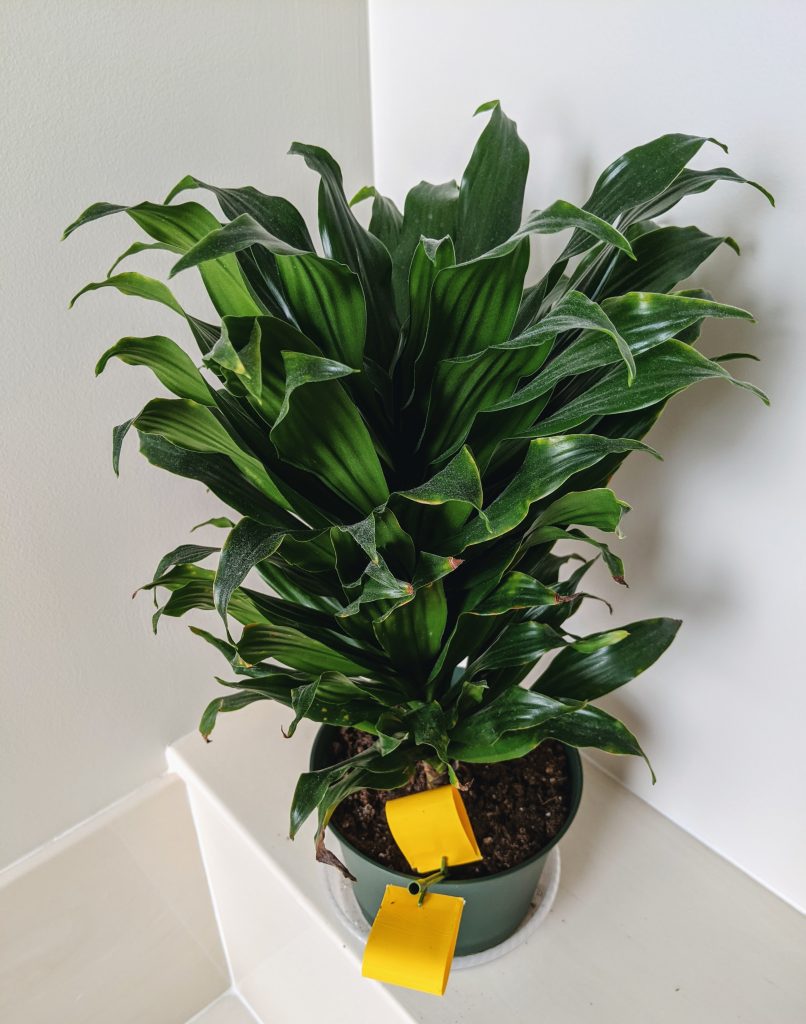
If you don’t have apple cider vinegar or don’t want to deal with the vinegar smell, these sticky traps also work very well. They’re yellow which is what attracts the gnats to them.
However, whether you use the apple cider vinegar method or the sticky traps, these only give you an indication of how bad your gnat problem is. You have to use these methods alongside dealing with the larvae problem.
Natural Ways to Prevent Gnats in Your Houseplants
Once you’ve gotten rid of these pesky bugs, there are a few tricks you can do to keep fungus gnats away from your houseplants and prevent them from coming back.
Avoid Overwatering
My number one tip is to avoid overwatering your plants and prevent fungus from developing in the first place due to the consistently moist soil.
Follow these tips for basic indoor plant care, including exactly how much (or how little) to water most plants.
Bottom Water
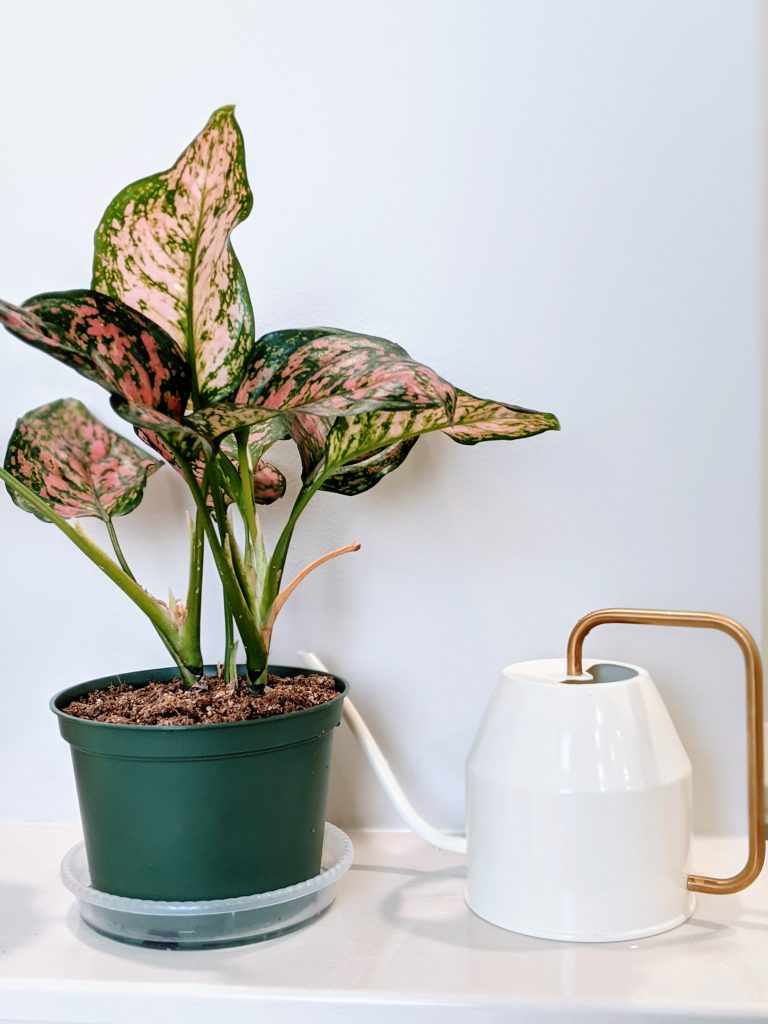
I recommend bottom watering your plants when possible. This helps reduce a moist environment on the top of the soil and deters fungus from developing in the first place.
As long as your pot has drainage holes, place your pot in a shallow dish of water and let it sit there for 5-10 minutes while the plant roots soak up the water from the bottom.
Inspect and Quarantine Each New Plant
Another tip is to thoroughly inspect any plant for gnats before bringing them home.
When choosing your new plant, in addition to making sure it’s healthy and has new growth, gently tap and squeeze the pot to see if any bugs fly out. If there’s bugs, pick another one.
Once you’re home, quarantine your new plant for 2 weeks away from other plants to make sure it didn’t come with any other unwanted bugs.
Use Irish Spring Soap
This is an age old trick that my grandmother taught me and one of the most inexpensive things you can do to deter gnats.
Grab a bar of Irish Spring soap (they’re super cheap), and finally grate the bar of soap using a vegetable grater/planer (a cheese grater will work in a pinch).
Sprinkle the soap shavings on the soil of your plants that are prone to gnats.
Occasional Hydrogen Peroxide Drenches
You may want to continue to do the occasional hydrogen peroxide drench on your plants for a few months after dealing with your gnat infestation. Once a month, use a small amount of diluted hydrogen peroxide to pour over the soil.
Use Sand or Rocks
Depending on the type of plant you have, you can also sprinkle a layer of sand on top of the soil. This prevents the adult gnats from penetrating the soil (they can’t get through the sand) and laying eggs.
For other potted plants, like orchids, placing a layer of rocks or pebbles should be used as opposed to sand.
If all else fails…
If you’ve tried out all the natural methods to get rid of fungus gnats and they still won’t go away, you might have to resort to something stronger.
A bonide systemic treatment is usually your best defense, as it treats the problem from the inside out.
This might be your last option before giving up and throwing out the plant.
Good luck getting rid of these annoying bugs. Do you have any other tips or tricks you’ve used to get rid of gnats? Let me know in the comments below. Or if you haven’t had a problem with them yet, save this post for later to reference if (and likely when) these bugs show up. Save an image to your pinterest board for the easiest way to save this post.
Dealing with mealybugs too? Here’s how to get rid of them
Visit my Houseplant Toolbox for a list of all my favorite supplies & goodies!
Stay Green!
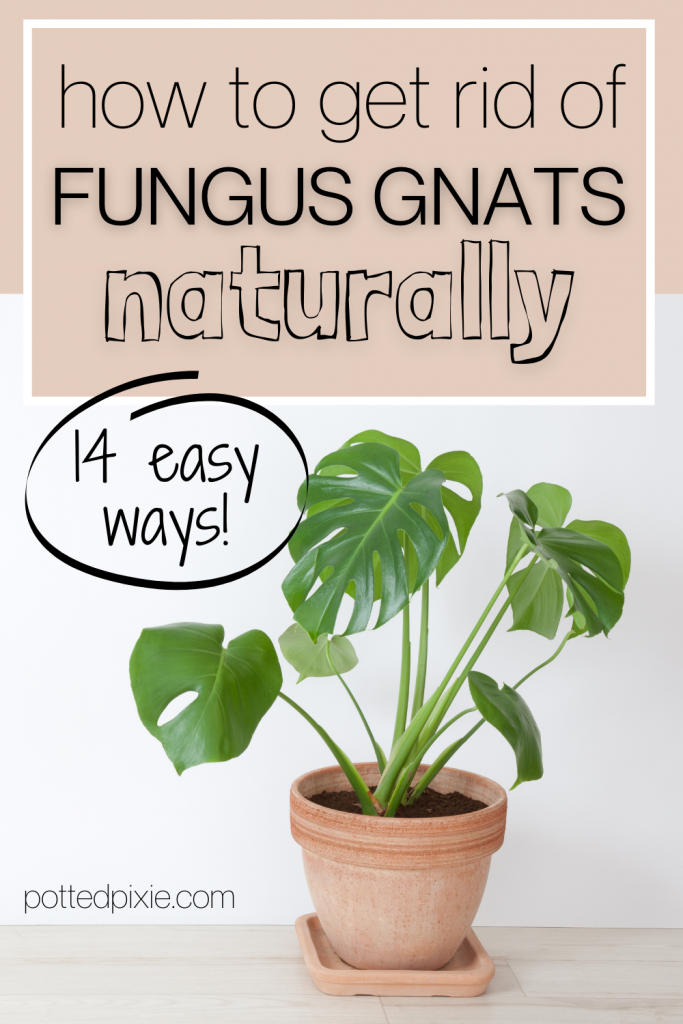



Very helpful tips, thank you 😊
Thank you so much for this info, I’m currently dealing with a major I’m Infestation and I don’t know which plant it is, it’s so frustrating gnats and flies everyday a d these plant as expensive as hell.
Thank you so much for your detailed tips. I am a new gardener and have started off with herbs. I repotted the plants using miracle grow which in the first place I wasn’t going to use but was the only one available at the time of purchase. Shortly after I noticed the little flies. I will try this recommendations. Appreciate it!
Can you use honey with the vinegar mixture instead of sugar?
Yes!
ive worked for interior plant companies for over 30 years
Gnat problems do stem from overwatering, but lately its also based in the soil mixes being used by the comercial growers in florida.
coco coir, (also used in mushroom production), has become a staple component of many soiless mixes used…curretly, we use Gnatrol, i believe is a bti natural product. But ive had success using 1 cup ammonia in a 2 gallon bucket of water, then watering normally. ammonia becomes nitrogen and the plant will respond with new green leaves…
Thank you!
I have grow tents w 7g pots, up to 6′ plants @ full bloom.
,Going to go for a combo of above. I have a bit much for some of these recipes.
Steps to remove gnats with dawn dish soap. Step 1: pour apple cider vinegar into a bowl. Step 2: add unscented dawn dish soap. Step 3: Place the dish soap gnat trap.